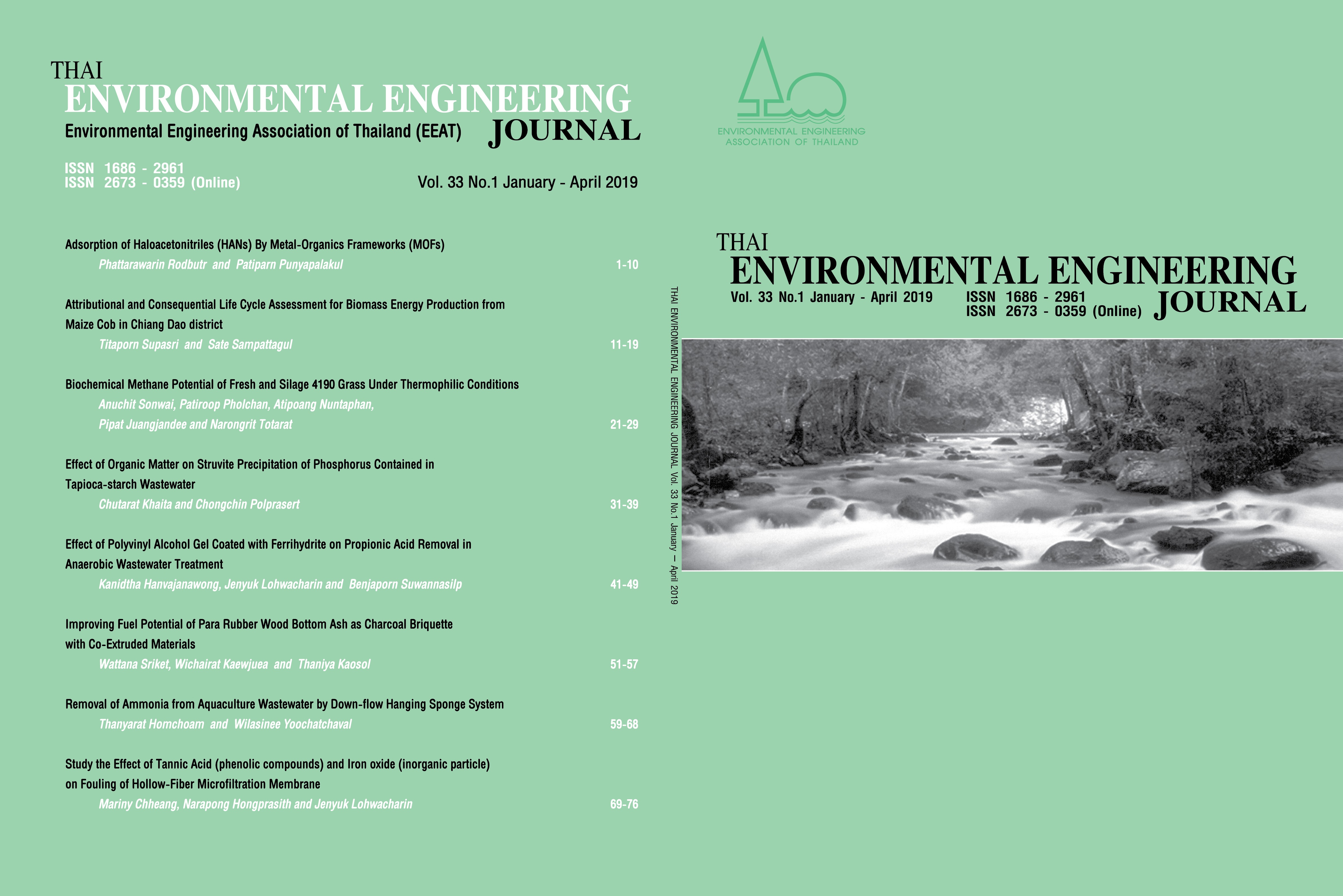Adsorption of Haloacetonitriles (HANs) by Metal-Organics Frameworks (MOFs)
Main Article Content
Abstract
This research investigated adsorption efficiency of HANs by using Dichloroacetonitrile (DCAN) as a represent on metal organic frameworks (MOFs; ZIF-8, MIL-53(Al), HKUST-1) and carbonized metal organic frameworks (C-MOFs; C-ZIF-8, C-MIL-53(Al), C-HKUST-1) comparing with powder activated carbon (PAC). ZIF-8, MIL-53(Al) were synthesized via room temperature method, and HKUST-1was synthesized via solvothermal method. Original MOFs were carbonized in tube furnace with N2 flow at 900 oC. The synthesized materials were characterized the crystallized pattern by X-ray diffraction (XRD). The screening experiment was studied to select the potential adsorbents C-MOFs. As a result, C-ZIF-8, C-MIL-53(Al) and PAC which process high adsorption capacities of DCAN, were selected for kinetic and isotherm study. The adsorption kinetics and isotherm were studied to examine the adsorption mechanism under batch condition. According to the results, the adsorption rate and capacity of C-ZIF-8 exhibited the higher amount than C-MIL-53(Al) and PAC. Pseudo-second order models were applied for adsorption kinetic models. The adsorption isotherm was fitted with Langmiur and Fruendlich models.
Article Details
References
[2] Hrudey, S. E. 2009. Chlorination disinfection by-products, public health risk tradeoffs and me. Water Res. 43(8): 2057-2092.
[3] Shah, A. D., & Mitch, W. A. 2011. Halonitroalkanes, halonitriles, haloamides, and N-nitrosamines: a critical review of nitrogenous disinfection byproduct formation pathways. Environ. Sci. Technol. 46(1): 119-131.
[4] Carter, R. A., Liew, D. S., West, N., Heitz, A., & Joll, C. A. 2019. Simultaneous analysis of haloacetonitriles, haloacetamides and halonitromethanes in chlorinated waters by gas chromatography-mass spectrometry. Chemosphere. 220: 314-323.
[5] Richardson, S. D., Plewa, M. J., Wagner, E. D., Schoeny, R., & DeMarini, D. M. 2007. Occurrence, genotoxicity, and carcinogenicity of regulated and emerging disinfection by-products in drinking water: a review and roadmap for research. Mutat. Res-Rev. Mutat. 636(1-3): 178-242.
[6] Carter, R. A., Liew, D. S., West, N., Heitz, A., & Joll, C. A. 2019. Simultaneous analysis of haloacetonitriles, haloacetamides and halonitromethanes in chlorinated waters by gas chromatography-mass spectrometry. Chemosphere. 220: 314-323.
[7] Jiang, J., Li, W., Zhang, X., Liu, J., & Zhu, X. 2018. A new approach to controlling halogenated DBPs by GAC adsorption of aromatic intermediates from chlorine disinfection: Effects of bromide and contact time. Sep. Purif. Technol. 203: 260-267.
[8] Cui, Y., Li, B., He, H., Zhou, W., Chen, B., & Qian, G. 2016. Metal–organic frameworks as platforms for functional materials. Accounts Chem. Res. 49(3): 483-493.
[9] Furukawa, H., Ko, N., Go, Y. B., Aratani, N., Choi, S. B., Choi, E., & Yaghi, O. M. 2010. Ultrahigh porosity in metal-organic frameworks. Science. 329(5990): 424-428.
[10] Murray, L. J., Dincă, M., & Long, J. R. 2009. Hydrogen storage in metal–organic frameworks. Chem. Soc. Rev. 38(5): 1294-1314.
[11] Chen, J. J., Chen, Y. T., Raja, D. S., Kang, Y. H., Tseng, P. C., & Lin, C. H. 2015. Carbonization and oxidation of metal–organic frameworks based on 1, 4-naphthalene dicarboxylates. Sci. Technol. Adv. Mat. 16(5): 054203.
[12] Zihuan Wang, Xiaoqian Ma, Zhongliang Yao, Quanheng Yu, Zhao Wang and Yousheng Lin. 2018. Study of the pyrolysis of municipal sludge in N2/CO2 atmosphere, Appl. Therm. Eng. 128: 662-671.
[13] Bakhtiari, N., Azizian, S., Alshehri, S. M., Torad, N. L., Malgras, V., & Yamauchi, Y. 2015. Study on adsorption of copper ion from aqueous solution by MOF-derived nanoporous carbon. Micropor. Mesopor. Mat. 217: 173-177.
[14] 46. Zhao, S., Yin, H., Du, L., He, L., Zhao, K., Chang, L., & Tang, Z. 2014. Carbonized nanoscale metal–organic frameworks as high performance electrocatalyst for oxygen reduction reaction. ACS nano, 8(12): 12660-12668.
[15] Tian, F., Cerro, A. M., Mosier, A. M., Wayment-Steele, H. K., Shine, R. S., Park, A., & Benz, L. 2014. Surface and stability characterization of a nanoporous ZIF-8 thin film. J. Phy. Chem. C. 118(26): 14449-14456.
[16] Chiericatti, C., Basilico, J. C., Basilico, M. L. Z., & Zamaro, J. M. 2012. Novel application of HKUST-1 metal–organic framework as antifungal: Biological tests and physicochemical characterizations. Micropor. Mesopor. Mat. 162: 60-63.
[17] 551.1, E. M., 1990. Determination of Chlorination Disinfection Byproduct, Chlorinated solvents, and Halogenated Pesticides/Herbicides in Drinking Water by Liquid-Liquid Extraction and Gas Chromatography with Electron-capture Detection. National Exposure Research Laboratory, Office of Research and Development, U.S. Environment Protection Agency, Cinicinnati, OHIO.


